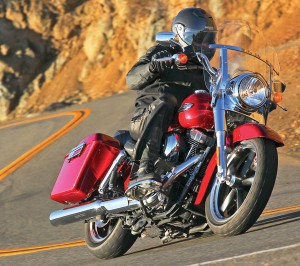
On the face of it, the central feature of Harley’s new 2012 Switchback seems simple enough. A quick-release windscreen and color-matched saddle- bags let you easily “switch back” from cruiser tourer to clean stylish custom and vice versa. Two bikes in one—double your pleasure, double your fun. Hit the road, grab the groceries or cruise the boulevard dressed or naked…OK, we get it. We’ve even seen this “Convertible” feature on earlier Dynas and today’s eponymous CVO Softail model, which is among Harley’s best-selling bikes. With the increased interest in baggers, it was only natural that a touring-equipped Dyna should make a reappearance.
But wait, there’s more. Swooping down the southern side of the San Rafael Mountains on Highway 33 in California on my first ride on the Switchback, going faster and faster and leaning deeper and deeper into the freshly paved S curves…nothing was dragging. The steering felt neutral and responsive, like a bike with a much shorter wheelbase, and the firm, well-damped suspension soaked-up my late braking and quick corrections to my line like mud sucks up your boots. Granted, the saddlebags were empty save for a water bottle and hook spanner I brought along for the rear suspension preload, but if this were a CVO Convertible sparks would be flying from the floorboards, I’d be phoning in my steering inputs from the top of the apehanger handlebar and the back end wouldn’t get the message till the next corner.
Then it dawned on me. Those clever Motor Company guys—“Switchback” must be a double entendre, referring to both the type of road the bike likes as well as its quick-change feature. Harley-Davidson, it seems, has gone and built a Dyna sport tourer! So the Switchback is really three bikes in one. Or is that six? Where are Wrigley’s and Ron Popeil when you need ’em?
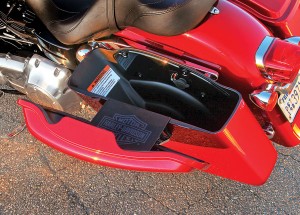
Anyway, before you go making comparisons to other sport tourers I, of course, mean a sport tourer in the Harley-Davidson sense. At 725 pounds wet it’s lighter than a 760-pound Heritage Softail or 810-pound Road King, has more cornering clearance than any of the Softails, and firm, well-damped Showa suspension front and rear with a tricky combination damper rod/cartridge fork in front. Tires are bias-belted but lower-profile than usual with a 160/70-18 in the rear and 130/70 in the front on a sporty, quick-steering 17-inch hoop. Rake is a cruiserish 29.9 degrees, but some offset brings the fork angle down to 28.9 degrees, close to earlier sporty Dynas such as the FXDS Super Glide, Super Glide Convertible and FXDX Super Glide Sport. These never got any real traction with Harley cruiser aficionados, but did get the attention of some sport and sport-touring enthusiasts. Perhaps the Switchback’s handling and removable windscreen and bags will once again attract riders from both sides of the aisle.
Not to mention its increased power. The sport aspect of the Switchback’s sport-touring theme is further enhanced by the Twin Cam 103 V-twin that replaces the TC96 in all of the Touring, Softail and Dyna models this year, save the Street Bob and Super Glide Custom. Easily recognized by the “103” emblazoned on the air cleaner, derby and timer covers, this bigger mill made its first regular production appearance in the 2010 Electra Glide Ultra Limited. Compared to the 1,584cc or 96ci Twin Cam, the air-cooled, 45-degree, OHV 103 or 1,690cc engine has the same stroke as the TC96 at 4.38 inches, but an 1⁄8-inch larger bore of 3.875 and slightly more compression.
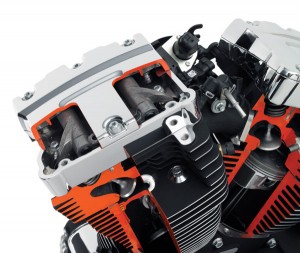
On the Jett Tuning Dynojet dyno it has the honor of being the first regular production Harley we’ve tested to top 70 horsepower and 90 lb-ft of torque at the rear wheel. The engine revs quickly with a throaty bark from its new exhaust—the only two-into-one pipe in the 2012 big twin lineup—and the increased power means plenty of grunt is always on tap for quick passes or two-up touring. I never felt any excessive engine heat, even riding in 90-plus degree temperatures. Hydraulic lifters mean no valve adjustments required, and the belt final drive is clean, quiet and almost maintenance-free as well.
Dyna and Touring family bikes are sometimes called “rubber glides,” because instead of having counterbalancers like the Softails, their engines are isolated from the frame and rider with elastic mounts. The system works pretty well in the Twin Cam 96 and FL Touring models, as side-to-side alignment is maintained by the mount design; shaking (theoretically) is only created and allowed in a fore-and-aft plane. This is the first Dyna 103 I’ve ridden, but it does seem to suffer more low-amplitude, low-frequency vibration (read: shaking) at certain engine speeds than TC96 Dynas and other rubber glides. Fortunately, there’s a sweet spot at faster cruising speeds on the highway where it smoothes out nicely. Since top gear in the slick-shifting Cruise Drive 6-speed transmission is so tall it’s like an overdrive, riding any slower I found that a downshift to fifth kept the grips and mirrors steady.
Ergonomically the Switchback is a peach. Its low, all-day comfortable, 27.4-inch-high seat means that just about anyone can plant their feet on the ground from the saddle. I’m not a fan of floorboards but the vibration-damped pair on the Switchback are nicely positioned, with nothing to prevent you from moving your feet well forward or back. The handlebar grips are at a very natural-feeling height and width on the rather normal-looking pullback bar, which Harley calls a “mini-ape.” We already have maxi apes—if this is now a mini, can micro ape hangers be far behind? Katy bar the door! Seriously, it looks just like the bar on a 1983 Honda CM450A, so the apes are taking over in name only.
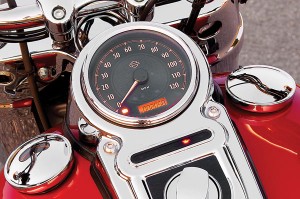
Despite the hairy primate references this is one of the most user-friendly big twins I’ve ever straddled. Throttle twist and clutch pull are the lightest I’ve ever felt on one of these bikes, and new, more tactile switchgear includes a button on the handlebar to scroll the LCD digital display on the tank nacelle among odometer, dual tripmeter, reserve range, clock and gear/rpm displays. Removing the windscreen is no tougher than sliding it off its four rubber-isolated mounts on the fork, which all but disappear when it’s off. Most riders will look over the medium-sized screen when seated, and it provides ample protection without much noise or buffeting and makes long rides tolerable, since you don’t have to fight to stay upright against the windblast.
The Switchback’s top-opening, locking saddlebags are keyed the same as the ignition and steering lock, with lids that pivot away from the bike for easier loading. They are probably the smallest factory hard saddlebags in Harley’s lineup, with a capacity of 15 pounds each, but their size makes them no wider than the handlebar ends and keeps the bike slender-looking when they’re mounted. Pull and turn a single knob within and they slide right off, their mounts also nearly disappearing from view. Just don’t forget to latch them after you slide them back on or you’ll ride off and they won’t.
The Switchback’s firm suspension works well in corners, under braking and doesn’t intrude on smooth roads, but like many cruisers there’s no escaping the punishment that front and rear suspension with just 3.9 and 2.1 inches of travel respectively must deliver to the rider on bumpy roads, even with triple- and dual-rate springs in the fork and shocks. Making sure the chrome-shrouded “cigar tube” rear shocks are adjusted using a hook spanner (not included) with enough preload for your weight is crucial, and even then be prepared to be jostled by the slightest pavement irregularity, though the bike will remain unruffled and never gets out of shape.
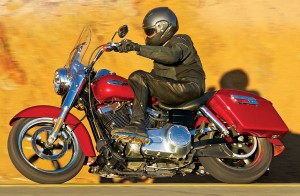
Harsh suspension on bumpy roads is nothing new in cruiser land, but I am surprised by the Switchback’s single front disc brake. With a 445-pound load capacity and 725-pound wet weight, you’d think dual discs would be standard out of the crate. Worse, the solo binder requires a lot of effort at the lever to use with gusto, so even though the brake is strong you’ll soon tire of needing all of it and slow down, where it works well enough. Fortunately for most riding, the front and rear brakes are fine in combination, and the hidden ABS is the smoothest operating I’ve experienced on a Harley to date, with almost no lurching or chirping of tires when it’s engaged, nor any pulsating at the lever or pedal. Hard panic stops are quick and uneventful.
While not as raked, slammed, chopped, blinged or blammed as full-on Harley customs and choppers, the Switchback does look really good with its touring kit stashed. The fully valanced front fender is the only giveaway that it’s a more than a bar hopper, as the chrome headlight nacelle, shock and fork shrouds, five-spoke wheels, polished rocker boxes and engine covers would be classy stuff on any custom. Other nice touches include a leather tank strap, fuel gauge and self-canceling turn signals. Seat bags or duffels strap easily to the passenger seat, though the tank-mounted speedo and ignition nacelle resist tankbags. The passenger seat is comfy, but avoid riding aggressively on bumpy roads with that short suspension travel or you may bounce your buddy right off.
As the lightest factory custom touring motorcycle in its displacement category, the Dyna Switchback is not only a quick-change artist, it offers easy, crisp handling with a low seat height and bags of torque. It’s the perfect second bagger for shorter, sportier cruiser-tours or stripped-down boulevard bashing—genuinely two-bikes-in-one. Or is that four? I dunno, you do the math….
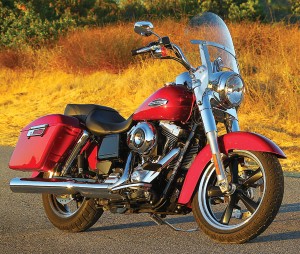 2012 Harley-Davidson Dyna Switchback
2012 Harley-Davidson Dyna Switchback
Base Price: $15,999
Price as Tested: $17,579
(Ember Red Sunglo paint, Security Package, ABS, Smart Security System)
Warranty: 2 yrs., unltd. miles
Engine
Type: Air-cooled, transverse 45-degree V-twin
Displacement: 1,690cc (103ci)
Bore x Stroke: 98.4 x 111.3mm
Compression Ratio: 9.6:1
Valve Train: OHV, 2 valves per cyl.
Valve Adj. Interval: NA
Fuel Delivery: Electronic Sequential Port Fuel Injection (ESPFI)
Lubrication System: Dry sump, 3.0-qt. cap.
Transmission: 6 speed, cable-actuated wet clutch
Final Drive: Belt
Electrical
Ignition: Digital electronic
Charging Output: 540 watts max.
Battery: 12V 19AH
Chassis
Frame: Tubular-steel double cradle w/ box-section steel swingarm
Wheelbase: 62.8 in.
Rake/Trail: 29.9 degrees/5.8 in.
Seat Height: 27.4 in.
Suspension, Front: 41.3mm cartridge fork, no adj., 3.9-in. travel
Rear: Dual shocks, adj. for spring preload, 2.1-in. travel
Brakes, Front: Single disc w/ opposed 4-piston caliper & floating rotor, ABS (as tested)
Rear: Single disc w/ 2-piston floating caliper, ABS (as tested)
Wheels, Front: Cast, 3.50 x 17 in.
Rear: Cast, 4.50 x 18 in.
Tires, Front: 130/70-B17
Rear: 160/70-B18
Wet Weight: 725 lbs. (as tested)
Load Capacity: 445 lbs. (as tested)
GVWR: 1,170 lbs.
Performance
Fuel Capacity: 4.7 gals., warning light on last 0.9 gal.
MPG: 91 PON min. (high/avg/low) 44.4/42.9/.41.3
Estimated Range: 202 miles
Indicated rpm at 60 mph: 2,200








I think this is a very good bike after riding one for 300 miles. I previously owned a Dyna LowRider and really liked it’s handling ability as well as the comfy ride from the 49mm forks. I thought maybe the smaller Switchback forks would be less plush, but they work well.
I traded my old Dyna for a new StreetGlide in ’08 and regretted it immediately. The StreetGlide rides like it has no shocks at all even though it’s heavier. I’m seriously looking to trade again for one of these new Dynas (I hate the Switchback name though).
By the way, I averaged 55 mpg while riding the Switchback.
I forgot to mention that I greatly enjoyed Mark’s un-biased story. Nice to read a fairly written article once in a while without all the usual Harley-bashing coming from the typical sport bike crowd.
John, it would be cheeper to just change the shocks on you ST. Glide, they only have 2″ of travel (to get that low down look), they are not cheep, but there are plenty of after mkt shocks out there, that would make a big diff.
Sandman, I did that. I found a used set of shocks from an Electra Glide. And yes, that made a huge difference in the ride. Best $75 ever spent.
I’ve looked at the FLD for some time along with the Triumph Thunderbird. The T-Bird cleaned its clock in the area of power, handling and brakes BUT the Harley was the ergonomic champ right out of the box. After a test ride, I was sold and put a deposit on a new Switchback.
The smaller bags are actually just right for me, as I pack light and here in California, the narrower profile is perfect for lane splitting. Later I will be adding a chopped Tour Pak and aftermarket Batwing fairing to improve the capacity and weather protection for 600 mile days.
I was especially blown away by the excellent handling, which rivaled my FXR I used to own. At almost 100 pounds lighter than the typical geezer glide, the FLD is a winner…
Have done 206,000 ks now,just about to change drive belt,1st time. Has been the most reliable bike out of 48 bikes I’ve owned,have replaced rear wheel bearings & engine management temperature switch,$51,has only been to the Harley shop twice,change oil & filter every 5,000 ks, primary oil every 10,000 ks. Best & cheapest bike ever to maintain